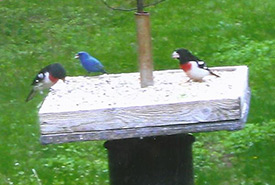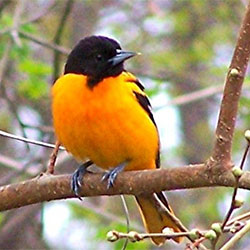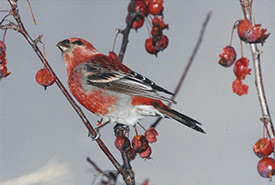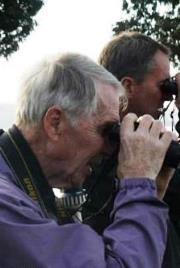Birds of the Happy Valley Forest (Part Two)

Two species commonly sharing the feeder: rose-breasted grosbeak and male indigo bunting. These and the oriole represent the greatest beauties in the forest. (Photo by Dr. Henry Barnett)
Summer birds
There is plenty of sound in the Happy Valley Forest, from the summering birds throughout the day and the woods only quiet down from September to late March. Some usually mid-southern birds have reached the Moraine to live.
I can recall the arrival of the cardinal to these parts. Jim Baillie phoned me at my Bloor Street office: "Barney, someone has reported that a singing cardinal has been heard in western High Park, just below Bloor Street." Together we took a streetcar to the end of the line, and even just as we descended we heard the loud call of this distinctive bird!
Since 1942, they have spread extensively in all Toronto ravines, parks and gardens. The northern mockingbird has made a lesser invasion in our gardens and ravines. It has recently been seen as far north as Baffin Island. Blue-grey gnatcatchers and tufted titmice are venturing in and breed in a few places in the Happy Valley Forest.

Northern oriole: One of the more spectacular birds of the forest. Notice the blue feet and bill. Clear notes, readily distinguishable. The bird is seldom quiet. The rose-breasted grosbeak has a more subdued but similar note. (Photo by Dr. Henry Barnett)
Crested flycatchers, wood pewees and nuthatches are regularly heard. So too are the oven-bird, yellow warbler, yellowthroat, Carolina wren, indigo bunting, mourning warbler, redstart, chipping and field sparrow, and less frequently grasshopper sparrows. Higher up in the canopy are scarlet tanagers and cerulean warblers.
Hairy and downy woodpeckers, as with the red-eyed vireo and pileated woodpeckers and two species of nuthatch (red-breasted and white-breasted), are usually heard on any visit to the forest in the summer, as is the brown creeper and the flicker.
All of the above are quite noisy and best heard at dawn and dusk. In earlier days least flycatchers were widespread in the Happy Valley Forest. Now they are heard only occasionally. The warblers are heard now less frequently than they were, including the chestnut-sided warbler. The yellow-throated vireo is heard less frequently also.
The common birds in the Happy Valley Forest in the summertime are:
|
|
|

The white-winged crossbill, a winter visitor feeding on remnants of wild apple and at our feeder. (Photo by Dr. Henry Barnett)
Song sparrow, field sparrow and the chipping sparrow are marked as "always," "regular" and "local only" on the checklist as the usual avifauna of the Happy Valley Forest.
Red tail, sharp-shinned, red-shouldered hawk, marsh harrier, kestrel, killdeer, screech owl, barred owl and horned owl are always expected.
Spotted sandpipers are commonly bred but not anymore. Regular but still rare visitors are breeding Acadian flycatchers. Incidentally, in the records in the 1930s of the "Kettleby Cabin," the Acadian flycatcher was an annual breeder as was the hooded warbler. We attributed them to new things but they were found in the Pottageville Swamp.
Unusual nesters
Daughter Ann Love took part with me in the five yearly summer breeding census run by the University of Guelph. Once a week (from April to July) we rose at 5 a.m. for five months and went to the Happy Valley Forest and the local ponds. Our nesting account was frequently the same from year to year.
Unusual nesting has only been noted once for least bittern, trumpeter swan, ruddy duck and gadwall. Marsh wrens are common nesters and singers in all the marshes in the Happy Valley Forest, but to find the nest requires a walk through the water. The hooded warbler became established with a successful nest in 2014. It appears to be moving northward. The Acadian flycatcher appears to have replaced the least flycatcher and is seen with increasing frequency each year.
This is the fifth in a series of blog posts Dr. Barnett will be contributing to Land Lines in the next few months.


